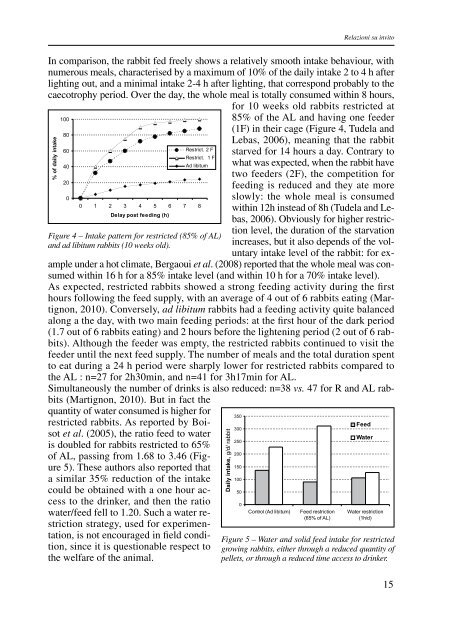atti delle giornate di coniglicoltura asic 2011 - Fondazione iniziative ...
atti delle giornate di coniglicoltura asic 2011 - Fondazione iniziative ...
atti delle giornate di coniglicoltura asic 2011 - Fondazione iniziative ...
You also want an ePaper? Increase the reach of your titles
YUMPU automatically turns print PDFs into web optimized ePapers that Google loves.
Relazioni su invito<br />
in comparison, the rabbit fed freely shows a relatively smooth intake behaviour, with<br />
numerous meals, characterised by a maximum of 10% of the daily intake 2 to 4 h after<br />
lighting out, and a minimal intake 2-4 h after lighting, that correspond probably to the<br />
caecotrophy period. over the day, the whole meal is totally consumed within 8 hours,<br />
for 10 weeks old rabbits restricted at<br />
% of daily intake<br />
100<br />
80<br />
60<br />
40<br />
20<br />
0<br />
Restrict. 2 F<br />
Restrict. 1 F<br />
Ad libitum<br />
0 1 2 3 4 5 6 7 8<br />
Delay post fee<strong>di</strong>ng (h)<br />
Figure 4 – Intake pattern for restricted (85% of AL)<br />
and ad libitum rabbits (10 weeks old).<br />
85% of the aL and having one feeder<br />
(1F) in their cage (Figure 4, Tudela and<br />
Lebas, 2006), meaning that the rabbit<br />
starved for 14 hours a day. Contrary to<br />
what was expected, when the rabbit have<br />
two feeders (2F), the competition for<br />
fee<strong>di</strong>ng is reduced and they ate more<br />
slowly: the whole meal is consumed<br />
within 12h instead of 8h (Tudela and Lebas,<br />
2006). obviously for higher restriction<br />
level, the duration of the starvation<br />
increases, but it also depends of the voluntary<br />
intake level of the rabbit: for ex-<br />
ample under a hot climate, bergaoui et al. (2008) reported that the whole meal was consumed<br />
within 16 h for a 85% intake level (and within 10 h for a 70% intake level).<br />
as expected, restricted rabbits showed a strong fee<strong>di</strong>ng activity during the first<br />
hours following the feed supply, with an average of 4 out of 6 rabbits eating (martignon,<br />
2010). Conversely, ad libitum rabbits had a fee<strong>di</strong>ng activity quite balanced<br />
along a the day, with two main fee<strong>di</strong>ng periods: at the first hour of the dark period<br />
(1.7 out of 6 rabbits eating) and 2 hours before the lightening period (2 out of 6 rabbits).<br />
although the feeder was empty, the restricted rabbits continued to visit the<br />
feeder until the next feed supply. The number of meals and the total duration spent<br />
to eat during a 24 h period were sharply lower for restricted rabbits compared to<br />
the aL : n=27 for 2h30min, and n=41 for 3h17min for aL.<br />
simultaneously the number of drinks is also reduced: n=38 vs. 47 for r and aL rabbits<br />
(martignon, 2010). but in fact the<br />
quantity of water consumed is higher for<br />
restricted rabbits. as reported by boisot<br />
et al. (2005), the ratio feed to water<br />
is doubled for rabbits restricted to 65%<br />
of aL, passing from 1.68 to 3.46 (Figure<br />
5). These authors also reported that<br />
a similar 35% reduction of the intake<br />
could be obtained with a one hour access<br />
to the drinker, and then the ratio<br />
water/feed fell to 1.20. such a water restriction<br />
strategy, used for experimentation,<br />
is not encouraged in field con<strong>di</strong>tion,<br />
since it is questionable respect to<br />
the welfare of the animal.<br />
Daily intake, g/d/ rabbit<br />
350<br />
300<br />
250<br />
200<br />
150<br />
100<br />
50<br />
0<br />
Control (Ad libitum) Feed restriction<br />
(65% of AL)<br />
Feed<br />
Water<br />
Water restriction<br />
(1h/d)<br />
Figure 5 – Water and solid feed intake for restricted<br />
growing rabbits, either through a reduced quantity of<br />
pellets, or through a reduced time access to drinker.<br />
15









